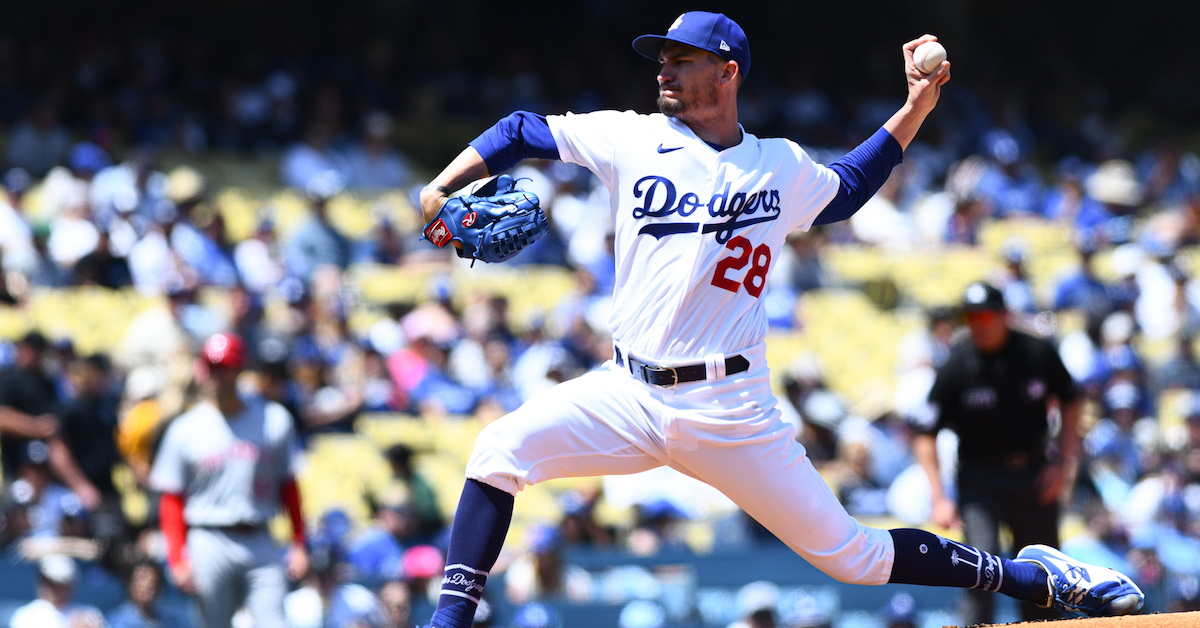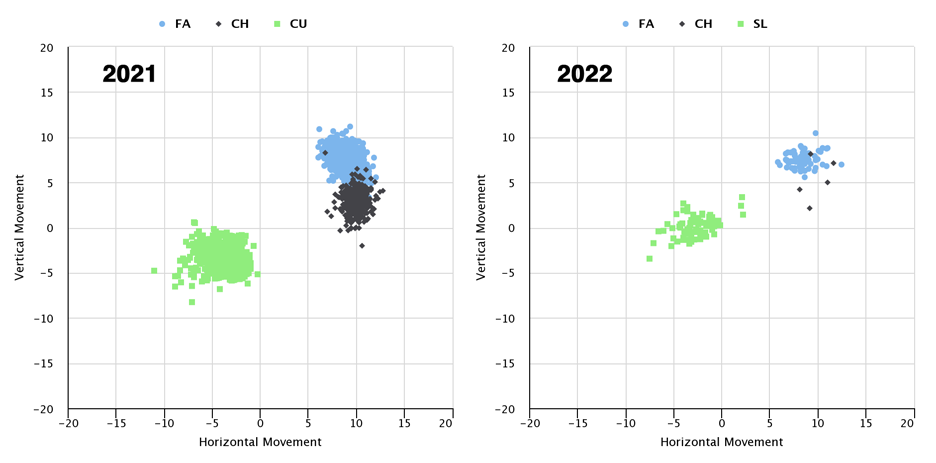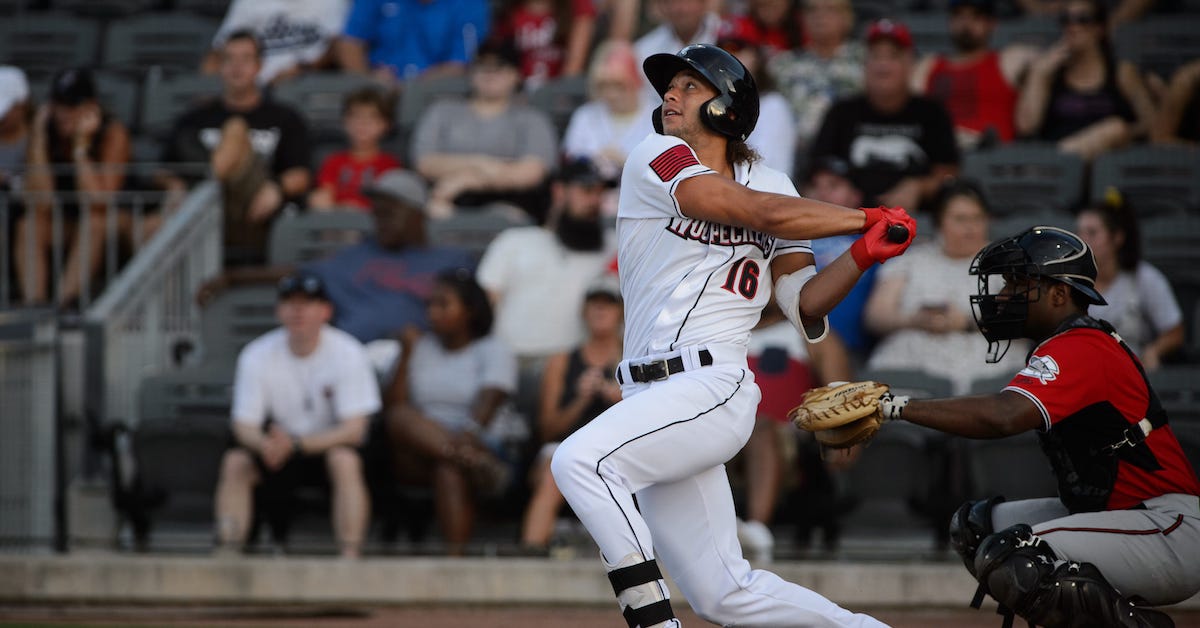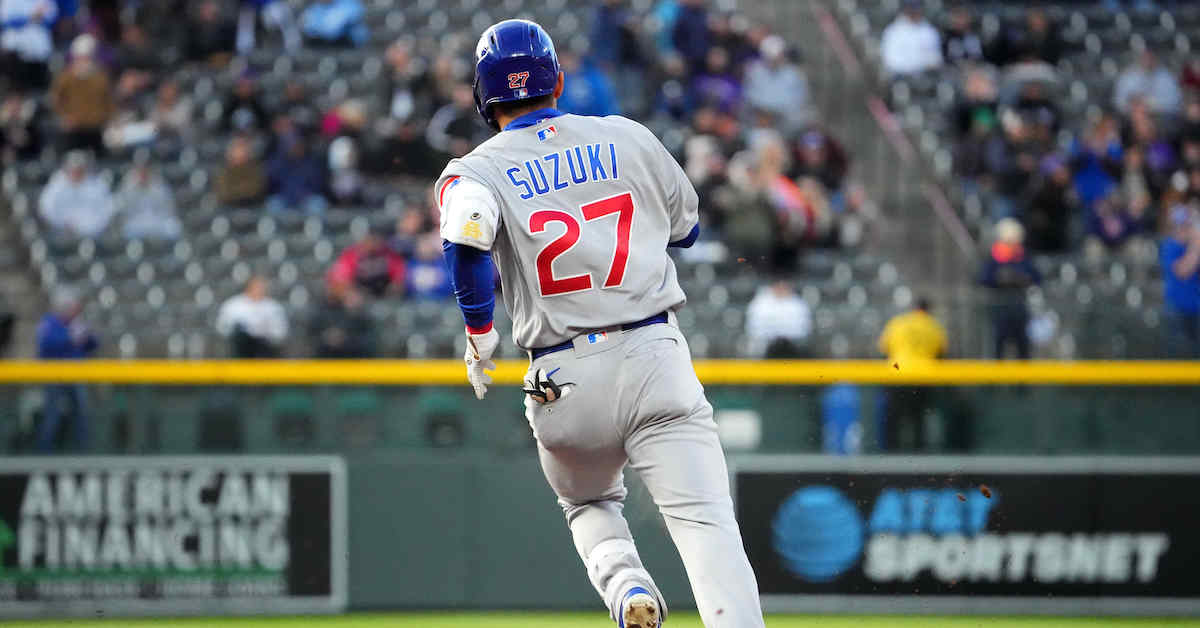The Sweeping Success of the Overhauled Andrew Heaney

Clayton Kershaw isn’t the only Dodgers lefty who has been putting up zeroes. So far in the young season, Andrew Heaney has thrown 10.1 innings without allowing an earned run through his first two starts, including one on Sunday, when he held the Reds to just one hit over six innings while striking out 11. In the wake of a disappointing 2021 campaign, Heaney has overhauled both his delivery and his repertoire, and it has quickly paid dividends for the Dodgers.
The 30-year-old Heaney signed a one-year, $8.5 million deal with Los Angeles on November 10, a surprisingly quick and lucrative signing for a pitcher coming off such a forgettable season. He didn’t crack our Top 50 Free Agents list, but he was the first free agent signed to a major league deal last fall, that after reportedly more than a dozen teams, including the Blue Jays, Cardinals, Nationals, Red Sox, and Reds, expressed interest.
Heaney spent the first four months of the 2021 season with the Angels, whom you may recall actually acquired him from the Dodgers in exchange for Howie Kendrick in what was effectively a three-way deal with the Marlins back in December ’14, at the dawn of the Andrew Friedman era. On the heels of three years of more or less league-average work with the Angels — and fewer injuries than usual — Heaney was hit for a 5.27 ERA through the first four months of last season, though his FIP was a more promising 4.06. As suggested by his .319 BABIP at the time, the gap between those two numbers owed something to his pitching in front of one of the majors’ worst defenses, and so his July 30 trade to the Yankees in exchange for prospects Janson Junk and Elvis Peguero made some sense. Old friend Eno Sarris summarized Heaney’s appeal:
Very interested to see what Matthew Blake does with Andrew Heaney. He’s always off the charts by advanced metrics (104 Stuff+, 107 Command+, top 25 K-BB), has high spin, low slot 4-seamer, and has underperformed his estimators. Tough park, but maybe some clay here to be molded.
— Eno Sarris (@enosarris) July 30, 2021
Heaney began his Yankees career in inauspicious fashion on August 2, serving up four homers in four innings — or really, four homers in the span of six batters while making his second run through the Orioles’ lineup. Things went downhill so quickly that by the end of the month he had lost his rotation spot, and made just one relief appearance after September 13. He was tattooed for a 7.32 ERA and 6.93 FIP in just 35.2 innings for New York, and finished the year with a 5.83 ERA and 4.85 FIP, his worst marks in any of the five seasons in which he’s pitched at least 50 innings.
Even given those gaudy numbers, it’s not hard to see the more tantalizing aspects of Heaney’s performance, some of which Sarris referenced. He stuck out 26.9% of all batters while walking just 7.3%; his strikeout-walk differential of 19.5% ranked 31st among the 129 pitchers with at least 100 innings last year, and was within 0.3% of the likes of Joe Musgrove, Walker Buehler, Alex Wood, and Frankie Montas, all of whom had successful seasons. Per Statcast, his 32.5% chase rate placed him in the 91st percentile, and the 2,443 rpm spin rate on his four-seam fastball put him in the 90th percentile.
That good stuff was undone by his allowing 2.01 homers per nine, the majors’ sixth-highest rate among pitchers with at least 100 innings. Heaney’s 89.3 mph average exit velocity (36th percentile), 40.8% hard-hit rate (32nd percentile) and 9.4% barrel rate (21st percentile) were nothing to write home about, either. His fastball averaged 92.0 mph, but on contact, it was hit for a .271 average and .537 slugging percentage.
As The Athletic’s Fabian Ardaya summarized, the Dodgers and other teams interested in Heaney liked his skill set enough to overlook last year’s results:
“His fastball possesses the type of characteristics teams crave. When he’s right, he’s shown an ability to miss bats. Los Angeles has shown an ability to better access that with certain arms, tailoring their pitching development to individualized results in a collaborative effort from the front office on down.”
In short order, the Dodgers have worked with Heaney to rebuild his mechanics, adjusting his arm slot, correcting his tendency to become too rotational, and placing him in the middle of the rubber instead of moving from side to side in search of a fleeting advantage. Their biggest move, however, was to junk Heaney’s curveball, which had below-average horizontal and vertical movement, in favor of a sweeper, a popular new variant of the slider that gets more horizontal movement. According to Sarris, on the Dodgers’ staff alone, seven pitchers including Buehler, Julio Urías, Blake Treinen, and Evan Phillips added a sweeper or adjusted their breaking balls to become one last year (Urías calls his version a slurve). Wrote Sarris in October. “[F]or most Dodgers sliders, the difference between the spin axis the batter sees, and the movement he expects from that spin axis — a phenomenon known as seam-shifted wake — is significant. That unexpected movement is up and out, so these sliders generally have less drop and more sweep than they appear they will as they spin out of the hand.”
When Heaney signed, Baseball Prospectus‘ Michael Ajeto correctly anticipated that the Dodgers would work to add a sweeper to his repertoire, given the mediocrity of his curve and changeup. Wrote Ajeto:
“Sweepers are great pitches in a vacuum, and if Heaney succeeds in folding one into his repertoire, he’ll almost certainly add more whiffs to his profile. But, like any pitch, its success is still dependent on its relationship with the pitcher’s fastball. Heaney’s fastball and changeup get more arm-side movement than average, and so it only makes sense that Heaney would take his curveball and make it move more side-to-side.”
Spoiler alert, that’s more or less what’s happened:

Via Statcast, Heaney’s curve averaged 46.8 inches of drop last year, whereas the new slider has averaged 39.9 inches. The new pitch actually gets less horizontal movement in an absolute sense (5.6 inches versus seven), but more movement relative to its vertical drop.
Given a spring training compressed by the lockout, the Dodgers and Heaney had a lot of ground to cover, and they could be forgiven if this overhaul wasn’t yet ready for prime time. So far, however, the results have been eye-opening. In his first appearance, on April 12 against the Twins, Heaney threw 4.1 shutout innings, allowing just three hits and an unearned run while striking out five. He generated 15 swings and misses on just 67 pitches, nine of which came from among his 34 sweepers (sliders, as Statcast records them, though at Baseball Prospectus, the Pitch Info leaderboard separates them out), including two put-aways apiece against Byron Buxton and Gary Sánchez:
Heaney also got six whiffs and eight called strikes from among his 30 four-seam fastballs, for a 47% CSW on the pitch and a 37% CSW overall.
On Sunday, Heaney retired the first seven batters he faced, five of them by strikeout. He struck out leadoff hitter Kyle Farmer and then four and five hitters Joey Votto and Tyler Stephenson via sliders, finishing the side off in the second by getting Aristides Aquino looking at a low fastball. He began the third by getting Mike Moustakas swinging at a slider, but walked Brandon Drury, and two batters later served up a double to Farmer, though Drury held at third. He escaped the jam, and worked around a two-out walk of Stephenson in the fourth while striking out Tommy Pham, Votto, and Aquino all swinging at sliders. He ended the fifth by whiffing Jake Fraley on a slider, and sandwiched strikeouts of Tyler Naquin (fastball) and Votto (slider) around a two-out walk of Pham in the sixth. Whew!
That was the first time Votto struck out three times in the same game against one pitcher since August 25, 2020, when Brandon Woodruff did a number on him. To find the last time a lefty did it to him, one has to go all the way back to September 10, 2010, when the Pirates’ Paul Maholm did so, joining the Giants’ Jonathan Sanchez (April 25, 2008), the Brewers’ CC Sabathia (four times on September 10, 2008), and Kershaw (August 30, 2009). Welcome to the club, Andrew Heaney.
According to Statcast, on Sunday Heaney got 14 whiffs from among his 39 sliders; throw in those four called strikes and that’s a 46% CSW for the pitch, and again a 37% CSW overall. For the two outings, the slider has produced a 36.5% swinging strike rate, and a 51.1% whiffs per swing rate. When batters have connected on the pitch, they’re 2-for-20, with both hits doubles.
Which raises a cautionary point: While Heaney is missing bats galore with his new toy, he’s also giving up a lot of hard contact. Batters have averaged a 93.3 mph exit velocity on the 20 balls they’ve put in play across his two starts, with a 55% hard-hit rate; all four hits he’s surrendered have been doubles, and loud ones at that, two by the Twins’ Carlos Correa (100.3 mph and 105.5 mph), one by Max Kepler (106.5 mph), and one by Farmer (97.3 mph). Hitters have only barreled one ball against him — a 108.2 mph third-inning lineout by Naquin that Cody Bellinger had to run down in center field — but of the eight balls the Reds put into play, five had xBAs of at least .370. Additionally, while sweepers tend to cause a lot of popups, Heaney has yet to generate a single one. But even with those hard-hit balls, the mix has still been favorable enough for Heaney that his xERA based on his Statcast numbers is 1.99.
On another positive note, the new-look Heaney has so far held lefties to a 1-for-13 showing, that after they cuffed him at a .280/.340/.451 (.339 wOBA) clip over the previous three seasons, compared to .243/.305/.463 (.324 wOBA) by righties. Small sample, obviously, and with regards to the new pitch, demonstrative of the extremes illustrated above: he’s finished five lefties off with the slider (including Votto three times), but of the two put into play, Naquin not only scorched that liner to Bellinger but also hit a similarly hot grounder (108.3 mph), albeit right at second baseman Gavin Lux.
For as impressive as his new offering is, it’s worth noting that Heaney is basically just working with two pitches; he’s thrown the four-seamer 48.7% of the time this year, the sweeper 48.1%, and his changeup just 3.2% (five times). Odds are that those limitations, and the hard contact, will catch up to Heaney, but for the moment his performance stands as an impressive testament to the quick makeover he and the Dodgers have undertaken.




